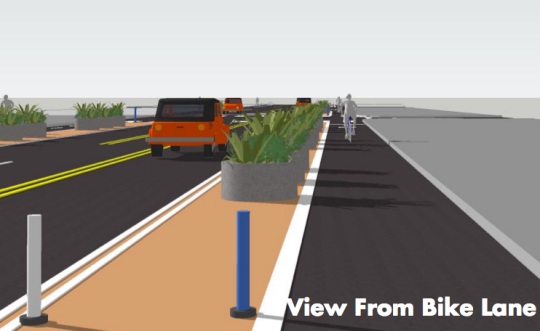
(Graphic: PBOT)
Nearly two years after an effort to improve east-west bicycle access through the Lloyd District shifted from NE Holladay Street, the Portland Bureau of Transportation (PBOT) has begun to implement their NE Multnomah Street Pilot Project.
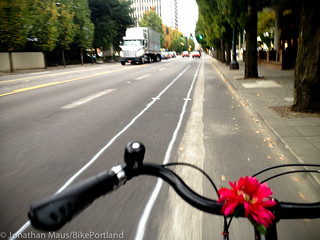
removed the old bike lane stripe, and is
prepping for the new buffered bike lane.
(Photo © J. Maus/BikePortland)
The project is an attempt to transform Multnomah from a sleepy, wide, and typically unexciting car-centric thoroughfare into a vibrant “main street” with protected bikeways and a more human-centered streetscape that will complement future development.
PBOT has changed the plans significantly since they were first unveiled back in May. They received lots of negative feedback that the design did not go far enough to create high-quality bicycling conditions. PBOT spent the summer tweaking the design to reflect public feedback and the desires of Lloyd District business owners and developers in order to reach a compromise that would satisfy everyone.
From what I’ve heard so far, the new design is much better for bicycling. Instead of the initial designs that forced people on bikes to weave from a few protected segments into many areas with standard, door-zone bike lanes adjacent to auto traffic, the new design offers either physically separated bikeways or buffered bike lanes along the entire length of the project (from I-5 to NE 13th). The final design also includes bike corrals — a feature that was glaringly absent (and only promised for the future) in the initial designs.
A PBOT design document shows one of the key changes from May’s design to the one we have now:
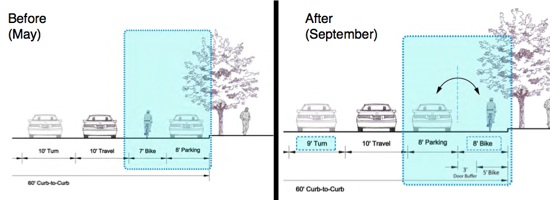
To help people better understand what to expect, PBOT has created graphic visualizations showing two types of buffers that bicycle riders can expect to see: “buffer planters” and “buffer delineators”.
The concrete planters are being reused from the Yamhill/Morrison transit mall downtown:
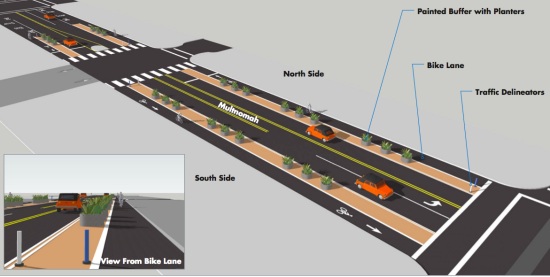
And the delineators are reflective traffic “wands”:
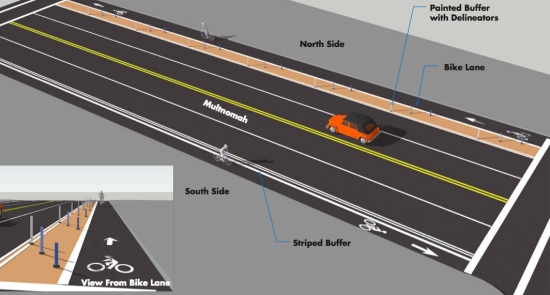
And now let’s take a quick tour of the cross sections from west to east…
NE Wheeler to 3rd:
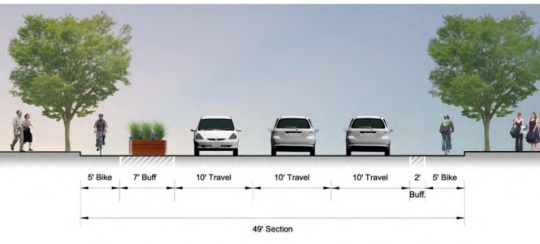
3rd to Grand:
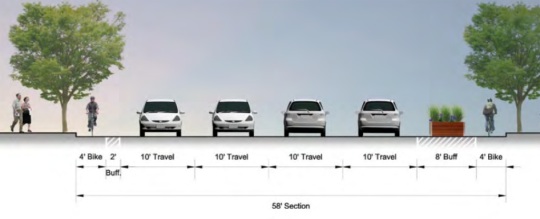
Grand to 7th:
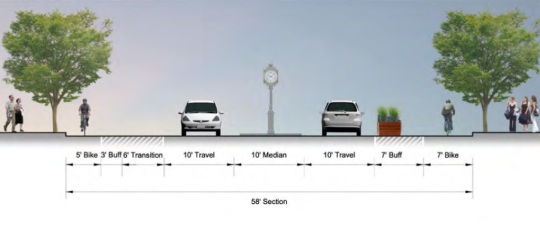
7th to 11th:
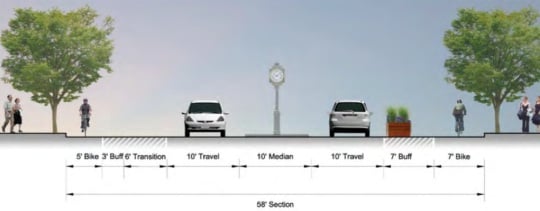
Holladay Park to 16th:
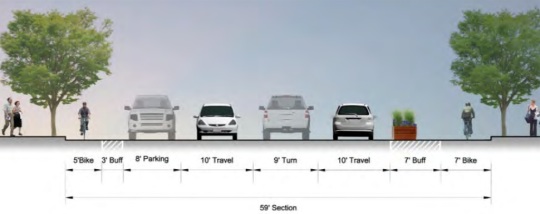
PBOT is also showing a “potential” parklet that could be built on the south side of Multnomah between 9th and 11th, adjacent to the Doubletree Hotel:

At the monthly meeting of PBOT’s Bicycle Advisory Committee this week, City bike coordinator Roger Geller said, thanks to public feedback and the involvement of the BAC, the new design is “Really much better than initially proposed… We’re pretty confident it will work well.”
Craig Harlow, a citizen activist and neighborhood resident who expressed “grave concerns” after seeing the initial plans, now says he’s pleased with how PBOT has responded to his feedback. “They’ve adopted many of the improvements that I’ve been asking for, including a widened, parking-buffered, curbside bike lane through most of the corridor.” Harlow says PBOT project managers also tell him they’ll sign the street for 20 mph.
PBOT’s Geller said they hope to have the project completed within the next few weeks; but they’ll need this rain to let up before they can continue with the striping.
— Learn more about the project and download the latest design drawings on PBOT’s website. For previous coverage, browse our NE Multnomah Project story tag.



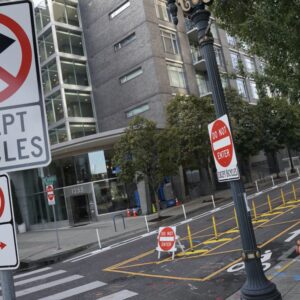
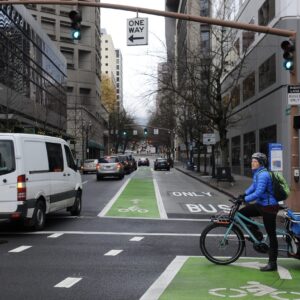
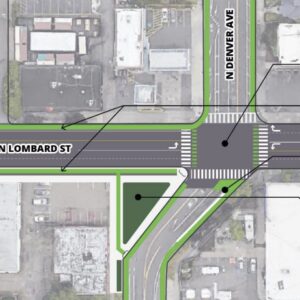
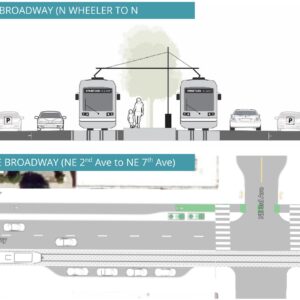
Thanks for reading.
BikePortland has served this community with independent community journalism since 2005. We rely on subscriptions from readers like you to survive. Your financial support is vital in keeping this valuable resource alive and well.
Please subscribe today to strengthen and expand our work.
WOW!! Thank you PBOT! This looks like a huge improvement over the old design.
Also, THANK YOU everyone who gave PBOT input. I bet it’s largely because of public input that PBOT improved the plan.
So, so excited for this– there were never enough cars on the road to justify the number of lanes. Does anyone know if they’ll adjust the timing of the lights? Right now they’re not very conducive for biking. Either way, this is way closer to “world-class” than I thought we would get based on the last go-round…
I asked about this at one of the open houses. The signals person was very helpful/friendly. Short version: He explained that since it’s a two way street (and not a pair of one ways), it’s extraordinarily difficult to time the lights to work well for both directions.
Looks really nice.
Are they really planning to have it up and running in just a few weeks?
Wherever there are barriers make certain that sweepers can and do get through regularly.
Still don’t understand the on street parking from 16th to the park. Movie theater parking lot on one side Lloyd center parking garage on the other.
Oh boy this is going to make the Lloyd District so much more appealing! It might even be worth riding through it to get somewhere else!
I love the idea of old transit mall furniture getting a second life, too. If only we could get some of those bronze and glass shelters back.
I agree with Cliff that the parking by the Theater parking lot is dumb, but other than that this is a MUCH better design than what was originally submitted. Our letters stating that nothing is better than TWO rows of parking everywhere seems to have worked.
Good job PBOT…..It looks like they are also keeping the upgrades eastbound on Holiday as well so there is an alternative for those heading east/south to the 12th street overpass. Excellent.
The rain just started. Is this still slated for 2012 implementation?
Photos: https://plus.google.com/118188104315965091545/posts
Yesterday, from NE 16th to NE 9th, on the north side of Multnomah, all of the old lane striping was scraped away, and skinny white guide striping was put down to mock up the new lane configuration. Also some full-on sharrows were put down too. In its current state, cars seem to have no idea where to drive, so they’re all over the place.
I am avoiding riding on Multnomah for the present, until clearer markings are in place.
Video of driver confusion/mayhem…
https://plus.google.com/u/0/108115841648639284222/videos
More plastic wands for some a-hole to intentionally run over until they rip out. Overall a great improvement though. Second J-R’s comment on sweepers.
Yes, can we please make these anchored metal bollards?
Also, seeing these plans make me that much more upset about the out NE Sandy project, where cyclists are getting 6′ lanes with no buffer between them and 50mph traffic, but the lane widths for vehicles are 12ft, with a 14ft turn lane. The project manager told me that they couldn’t take any space from the turn lane to add 1′ bike buffers. I now see that this response was complete BS.
http://bikeportland.org/2012/08/20/odot-project-will-add-bike-lanes-to-ne-sandy-blvd-in-east-portland-76242
The currently planned plastic wands are being configured to allow bikes to move across the buffer into the adjacent lane, i.e. to set up for a left turn, pass a stopped bus, etc….probably a dangerous scenario for those on bikes, if solid bollards of metal or concrete were to be implemented there.
Well, the bollards will be gone within a few weeks, anyway. Might as well just save the money and leave them out of the design.
With those graphics and the frequency with which the word buffer keeps appearing it is hard to maintain that bike infrastructure isn’t primarily about mitigating the dangers that cars and their occupants pose to everyone not in cars. Maybe we can bury the Beth Slovic bike-infrastructure-takes-money-away-from-the-carbound framing once and for all?
Thanks for the update and what seems like a much better outcome. If Craig Harlow’s happy that seems like a good sign.
:^)
Ya got status…
Does it pass “The Harlow Test”? (sorry Elly)
this looks good from my point of view as a slow rider… but it will suck for those trying to get anywhere fast since there’s no room for passing in those narrow bike lanes…
cars are all generally capable of maintaining a set speed…
bike speeds vary greatly depending on the terrain and the rider…
I think all bike lanes should be built with passing in mind otherwise they’re not good for commuting…
cars are still getting 1.6 to 3 times as much room on the road after the makeover so we’re still encouraging car use on this street…
I’m really thrilled to see this, and even more so given my disappointment with the N Williams redesign. I may be able to use this as a better alternative to Williams in getting from downtown to Hollywood.
This is great! The new design reminds me a lot of how bike-ways are set up here in Europe. Safe and separate from the auto traffic! -Portland is truly my favorite U.S. city and I can’t wait to ride the new bike-ways during my next visit! =)
wow. MUUCH better. This looks like it has a lot of potential.
Lookin’ good!
This looks soooo much better. As someone who was outspoken at the open houses, a big thank you to PBOT. And a 20 mph limit – Wow!
PLEASE NOTE that nowhere in the PBOT plan, website, or other public communications has a 20 MPH speed been described.
However, when I first asked for the 20 MPH change, and in numerous subsequent meetings with PBOT, project staff assured me that the speed reduction was “assumed” and would definitely be implemented.
If you care about this speed reduction, contact the project team. From their webpage:
“For more information, contact project manager Ross Swanson at multnomah.mainstreet@portlandoregon.gov or 503-823-6829″
i would be surprised if they have authority to post a 20 mph limit. the counts are much higher than the 2k per day limit under the statute.
http://www.portlandmaps.com/detail.cfm?action=Traffic&intersection_id=46915&x=7649520.047&y=687244.933&site_name=NE%20MULTNOMAH%20ST%20and%20NE%209TH%20AVE&city=PORTLAND&ResultCount=1
Looking at it again, it seems like SIGNIFICANTLY less parking than earlier drafts – Instead of mostly parking, it looks like just on one side of the street, and only for about 5 blocks. Is this really true? If so, wow! Comments about all the underutilized parking in the area worked!
I was surprised by this too! Much better use of the space in this current design.
I applaud PBOT for the protected bikeway, but wonder if they haven’t taken the design far enough. The westbound facility feels like a poor sister to the east bound facility. A more convincing scheme for separation is needed. Has a bi-direction facility been explored for the street? This might provide an opportunity to better use the existing street space and might even provide opportunities for some curbside parking along the north curb (Grand to 11th)- something the business community would appreciate.
“Harlow says PBOT project managers also tell him they’ll sign the street for 20 mph.”
Wow! That’s forward-thinking.
This redesign is much better. I am very happy to see that PBOT listened.
The diagonal lines of plastic bollards are rather non-standard. I would hope that these could be replaced by a asphalt or concrete curb in the future. The planters look better.
I do not want my ability to access a turn lane or mid block location to be impeded by a concrete barrier.
Great! This is a positive outcome.
However, looking at these street profiles angers me somewhat. Why cannot the cycling lanes be a consistent width?! On each street profile auto lanes remain a consistent width of 10′.
Cycling lanes vary from 4′ to 7′. Plus, the 4′ and 5′ cycling lanes could be widened when the buffers are 3′ to 8′. Are predetermined planter widths receiving priority to a 7′ cycling lane?
On the 3rd to Grand profile why not make a 5′ buffer and a 7′ cycling lane?
Too often bicycle lanes seem more like slalom obstacle courses at times, with constant variation.
We cyclists are deserved, via safety, of consistent road infrastructure.
This looks much improved and awesome compared to the first draft. Curious what they’re doing about bus stops. Any money left to build some sweet platforms with bike lanes that go around them like the build in the Netherlands and, erm, Seattle? (http://www.activerightofway.org/p/solving-the-busbike-leapfrog-bus-islands-buffered-bike-lanes-in-seattle/)
Whee! Nothing says, “I don’t belong on Oregon highways with my bicycle” like special, separated infrastructure.
It’s just a temporary thing while those still in cars figure out that their mode is on its way out.
Then we’ll take the lane. Whee!
The parts of our state that don’t have bike-specific infrastructure enjoy bike modal shares below 1%. I’ll take our limited special infrastructure and 6+% modal share over that…
Your dreams will come true when we leave the era of cheap energy.
First the oil will go and the motoring masses will flock to electric cars (those that can afford them) and public transportation.
Then the natural gas will go to the trucking industry because they’ve had the foresight to plan for an OPEC free future. While autos exist that can run on natural gas they are few and far between. We can expect either public rationing or more likely a fuel tax waiver for the freight industry.
With the abundant liquid energy sources becoming too expensive for the masses we are left to rely on battery technology. Capacity and cost issues aside there are material resource scarcity issues here too.
What’s more is that many of these resources come from far overseas on the shipping fleets totally dependent upon diesel and lower grade petrochemicals like bunker fuel. These will be increasingly refined into higher profit diesels and gasoline robbing the shipping industry of the cheap fuel that makes overseas trade competitive.
Sometime after the cost of driving a car looks as fiscally irresponsible as flying your personal aircraft to work daily the trucking industry will face the same reckoning. Natural gas will be fuel of choice for grid tied electricity producers; cheaper by GigaWatt or not it makes for the most cost effective power plant and most capable of meeting fluctuating load demands.
This will draw the trucking industry down as our society learns that energy efficiency is survival.
If the roads haven’t crumbled by then they will be car free.
OMG, I work over there. This would be a massive awesome change to that street. Extremely exciting.
I always worry about buffered bike lanes like these, especially with obstructions like parking and planters, increasing the right hook and left cross risk. I’d feel a lot safer with a non-door-zone bike lane.
i don’t have much intention of hanging in a curbside bike lane westbound approaching bus stops at grand and at 3rd. eastbound, i usually pick multnomah up at 13th coming off the 12th overcrossing, and then making a left onto 16th. that maneuver is made more difficult by the proposed configuration, which requires me to come out from behind a planter at some point. very likely i will continue my present practice of asserting the travel lane and then merging into the left turn lane. the fact that the dedicated bike facility is now “over there behind those planters” will make it that much more obvious that i am violating the mandatory sidepath law. repeal.
After looking at the number more closely, I am still somewhat disappointed in this design. With the amount of bike traffic expected on this street, the bike lanes should be 8 feet wide, to provide plenty of room for 2 bikes to pass (even if one is pulling a trailer). The buffer should be at least 2 feet wide, though 3 or 4 feet is better. So, can we get this?
NE Wheeler to 3rd: the plans show 19 feet for bikes/buffers. This could provide 8 foot wide lanes with 1.5 foot buffers on each side. There could be a single line of bollars or a 6 inch curb (with 45 degree angle on the inside).
3rd to Grand: 4 travel lanes for cars?! There is 18 feet for bikes. Reduce the car lanes to 3, as in the rest of the plan, then there will be 28 feet – enough for 8 foot bike lanes, 2 to 3 foot buffers, AND an 8 foot parking lane on one side, which local retail businesses would appreciate
Grand to 7th: There is only 30 feet of car lanes and median, but the design is compromised due to having the bus stops at the existing curb, with the bike path weaving to the left around the bus stop. The better solution is to have the buses stop right in the main travel lane, and unload to a new elevated concrete sidewalk/buffer area. With 28 feet there is room for 8 foot bike lanes and 6 foot buffers on each side. 6 feet is wide enough for a bus stop and benches, but if not, the median could be narrowed at this location, and the buffer bulbed out, to provide extra bus stop width. http://www.aviewfromthecyclepath.com/2011/10/bus-stops-which-dont-cause-problems-for.html
Holladay Park to 16th: This makes the most sense, except that the parking side has an excessively narrow bike lane. Reduce the other side to an 8 foot bike lane plus 4 foot buffer, and then there is room for an 8 foot bike lane and 3 foot buffer next to the parked cars, on the other side. This is jus about perfect, and should be the standard on the western blocks as well.
To recap, the better design from Grand to 16th would be:
8 foot bike lane, 3 foot buffer, 7 foot parking, 10 foot car travel, 9 foot turn lane / median, 10 foot car travel, 3 foot buffer, 8 foot bike lane = 58 feet. This provides room for 2 bikes to pass with ease along the whole route, provides enough buffer width to prevent car doors opening into the bike lane, and keeps the car lanes narrow enough to reduce speeds, to improve the street environment for pedestrians.
I believe this would be similar to the standard design for the Netherlands Ideally, the bike lanes would be a different color and surface of pavement, and the buffer areas would be elevated curbs with concrete or paving stones, and the bike lanes would clearly be given priority over turning traffic at curb cuts and cross-streets.
The buffer should be accessible so that cyclists can:
a) pass other cyclists,
b) exit the bike lane for a mid block location (on the left).
c) exit to enter a left turn lane.
The addition of planters that impair sight lines of motorists at intersections is likely to be dangerous. Ironically, several studies in copenhagen have shown that fully separated facilities significantly increase the risk of accidents at intersections.
Kills me that these designs show absolutely no accommodation for left turns at intersections or midblock crossings for cyclists. I love cycle tracks but these designs are incomplete if they don’t accommodate all movements for cyclists.
Does this mean that Portland Bicyclists will actually obey the law now? If we’re spendig the money on this, I most certainly hope so. Not every cyclist disobeys the laws. But I’ve almost been hit numerous times crossing at a crosswalk where I’ve had the right away, as the cyclist apparently felt that the Red Light was “more of a suggestions than a rule”, so you’ll forgive me if I’m a tad “bitter”.
yes, jamie, a row of planters means somebody is going to change their behavior. as a pedestrian in a marked crosswalk with the “walk” sign lit, i have been “almost hit” by any number of right turning, and for that matter left turning motorists, but i am not bitter, and i am not asking you to forgive me.
Probably not. Enforcement/education is separate from infrastructure projects, and I’ve never heard of any infrastructure projects – for people driving cars, people walking, or people riding bikes – being held hostage to a behavior change. Though you got me thinking – It would be interesting if we didn’t spent any more money on projects mostly benefiting cars until all drivers yielded the right of way when legally required…
“I’ve never heard of any infrastructure projects – for people driving cars, people walking, or people riding bikes – being held hostage to a behavior change.”
Then you’ve not hung out with Amanda Fritz.
http://bikeportland.org/2011/12/29/reader-story-passerby-helps-calm-aggressive-honker-64399#comment-2398062
Believe me, I know there are PLENTY of A-hole drivers out there that can’t drive to save their lives (and many of them parents, who expect their kids to do what they’re told, but can’t be bothered to park correctly between 2 white lines, or even to use a blinker), but as this article is about bikeways…
the article is indeed about bikeways. it is not about compliance, or even courtesy, of individual users. nor is it about your individual anecdotal experiences, nor your bitterness, nor forgiveness.
And yet, the forum is public, and I’m not the only one posting opinions about issues that are related to the bikeways, and not just the bikeways. I have my opinion, and I expressed it. It’s not like I started talking about politics, religion, sports, movie stars; my post is still related.
okay, then let me ask you this. you know those new merge lanes they are going to put in at the convergence of the two interstates, completely tearing up what is left of lower albina? when they put those in, will motorists all of a sudden “actually obey the laws”? or do those two things seem somehow unrelated to you?
Probably not, but that is a great question. You’ll note that I completely acknowledged that there are terrible drivers out there as well in a previous post. I’ll add that they definitely need to be dealt with as well. I for one definitely try to obey the law when I drive. I use my signal, I definitely check for bikes and pedestrians, and I give the proper right away. However, from personal experience, I’ve seen police in the Lloyd district ignore bicyclists blowing lights, cutting across lanes, etc. If a motorist tried that, they’d be ticketed on the spot. Believe me, my issues with stupidity are targeted toward drivers as well, and when an article comes up about automobile drivers, I’ve posted similar comments. But, since this article happens to be about bikes…
Quite frankly, if you’re not one of those cyclists I’m referring to, then you have nothing to be upset about. If you are, well, figure it out. I don’t know you, so I make no assumptions.
let’s say i am not one of the cyclists you are referring to. here is why i nonetheless have something “to be upset about.” though in reality, i am not upset, i am trying to help you clarify your thinking so you will not come back on these boards spewing more nonsense.
this is an article about specific changes that are being made to the streetscape in a particular place. you come on the board and say, if the city is spending money on something that benefits cyclists, there should be some expectation that certain individual cyclists will change specific behaviors that, when you think about it, are actually unrelated to the facility in question. when i compared this to expecting motorists to change their behavior because money is being spent on freeway ramps, you acknowledged the validity of the analogy.
so why say it in the first place?
okay, as it turns out the answer is you had not thought it through. but now that you have, can we please not hear this again? and if you are on other boards elsewhere and people are raising this idiocy, can you please jump in and say hey, you are wrong? and help others clarify their thinking? and eventually the world becomes a better place?
all that being said, this particular design actually interferes with my safely operating a bicycle on multnomah, in ways that i have specified elsewhere on this thread. so even your first premise, that money is being spent to benefit cyclists, is flawed.
I definitely don’t see it as nonsense, or I would not have said it. At the end of the day, I honestly don’t care if you see it as nonsense or not. I’m not aware of any other forums where I can actually remind cyclists that they have laws too, and that they should start obeying them. Yes, believe me, I absolutely thought through what I typed. Don’t assume you know me. Yes, I agreed on the analogy for cars. But then, cars have speed traps, intersection cameras, speed bumps, and all sort of things that are meant to encourage automobile drivers to drive like they actually care about someone but themselves. Again, not all cyclists in Portland ride like they don’t give a damn, but many do, and I don’t see anything being done about them. I may be a lone voice. I don’t really care. I’m tired of cyclists in this city acting like they’re entitled, and if nothing else, this is as valid a place as any to let the cyclists know that some of us actually notice them blowing the lights and nearly running people down.
Hmm. This was in reply to “are”. Seems like it got placed in the wrong spot.
Jamie – Though I agree that bikes should have higher compliance levels, I’m not sure I agree with your analogy. Speed traps and such clearly don’t lead to 100% compliance among cars, which is what you seem to be asking for bikes. (And I don’t see you posting on news article about road funding that we should now expect people to drive better.) And in fact, police do occasionally run “stop sign” traps at bike-heavy intersections – Check out previous posts on this site for some of that. So it seems that some enforcement exists for both folks driving cars and folks riding bikes, but in both cases (like pretty much any other law on the books) the enforcement doesn’t mean everyone follows the law.
That said, most people would consider ideas such as “we shouldn’t spend money on any modifications to I-5 until all people driving follow every law” absurd, and that the same absurdity applies to bike infrastructure projects.
So yes, I agree with you – It would be wonderful if all road users followed every law. But since that is a lofty goal, it seems unfair for you to single out those that ride bikes for the wishful thinking.
(For what’s it’s worth, I often tell fellow bike riders that “you make us all look bad” when they run red lights. And I don’t yell at people driving that run reds. Though I see drivers run red lights in front of police without being pulled over on a regular basis in the Lloyd district, just as I see bike riders run reds.)
i have seen police cars running reds in lloyd